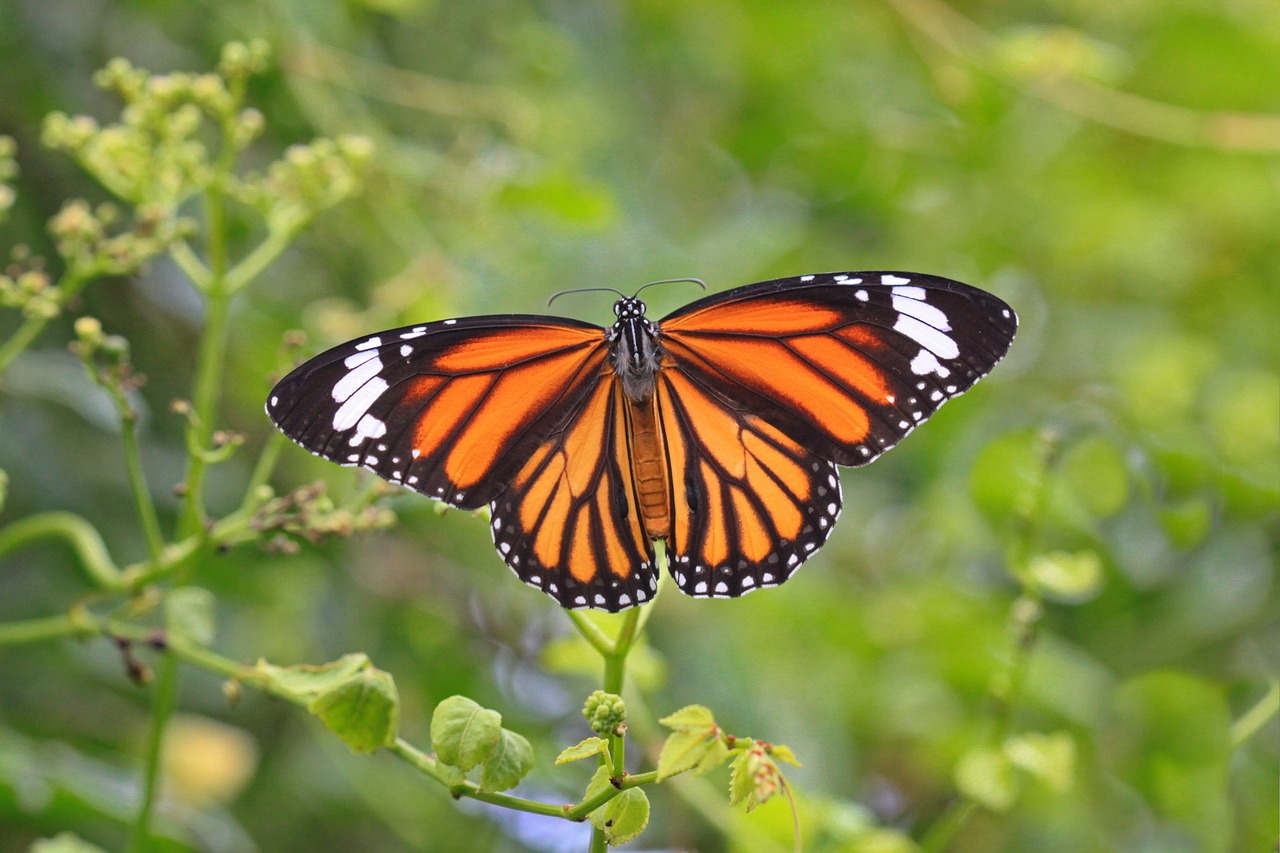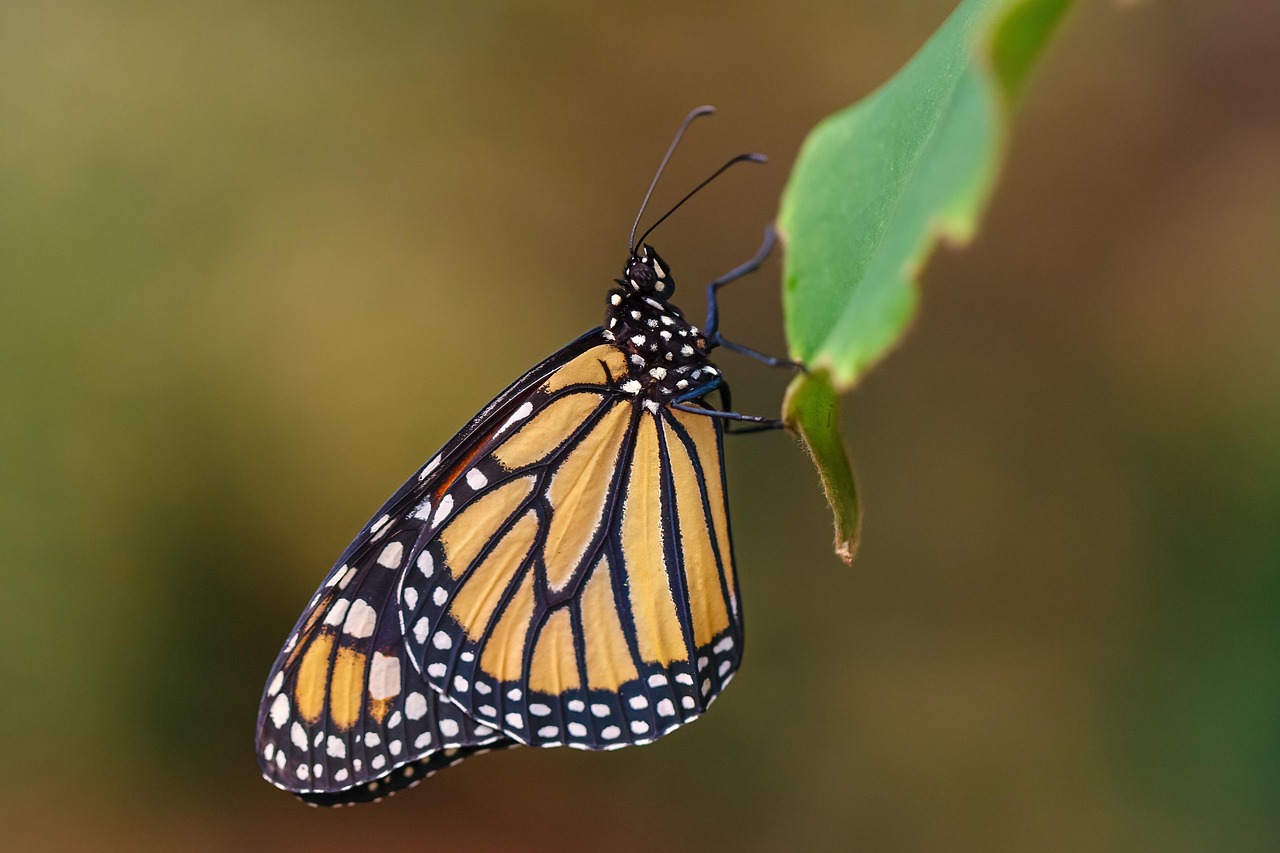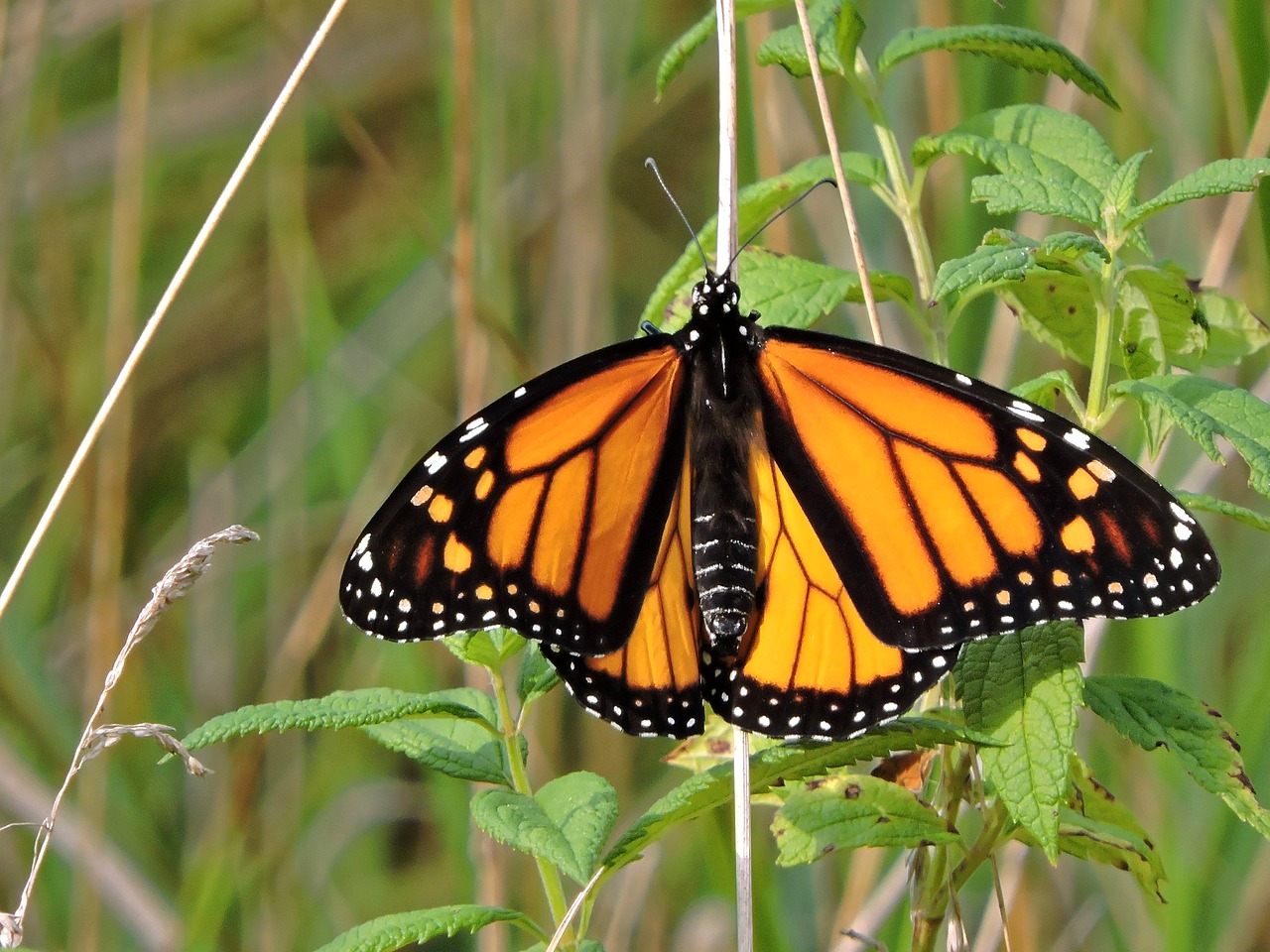Monarch butterflies defend themselves from predators primarily through chemical deterrents, mimicry, and their striking coloration. Their larvae feed on toxic milkweed plants, which makes them unpalatable to birds and other predators. Additionally, their bright orange and black patterns signal danger to potential threats.
Monarch butterflies (Danaus plexippus) are one of the most recognizable insects in North America due to their vibrant colors and unique migratory patterns. These butterflies can travel thousands of miles from their breeding grounds in Canada and the United States to wintering sites in Mexico. However, their journey is fraught with challenges, including the constant threat of predation. To survive, monarchs have developed several fascinating defense mechanisms that not only protect them but also help them thrive in their natural habitats.
One of the most significant aspects of a monarch’s defense strategy is its diet during the larval stage. Monarch caterpillars are known for feeding exclusively on milkweed plants. Milkweed contains toxic compounds called cardenolides, which are harmful to many animals. When caterpillars consume these plants, they store the toxins in their bodies, making them distasteful and potentially lethal to predators. This process is known as sequestration and offers the caterpillars a degree of protection from birds and other predators.
Benefits of Toxicity

The toxicity acquired from milkweed not only protects monarch caterpillars but also extends into adulthood. Adult monarchs retain some of these toxins, making them unappealing to predators such as birds. This phenomenon is a classic example of chemical defense in the animal kingdom, where an organism uses toxic substances to deter potential threats.
In addition to their chemical defenses, monarchs exhibit a form of mimicry known as Batesian mimicry. This occurs when a harmless species evolves to imitate the warning signals of a harmful species. The bright orange and black coloration of monarch butterflies serves as a warning to potential predators that they are not suitable for consumption. This visual cue helps reduce the likelihood of predation, as many birds learn to associate these colors with a negative experience.
The effectiveness of these warning colors can be observed in various studies that show predators tend to avoid brightly colored insects after a few encounters. When a bird tries to eat a monarch and experiences an unpleasant taste, it quickly learns to avoid butterflies with similar coloration in the future. This behavioral adaptation not only benefits individual monarchs but also enhances the survival rate of the entire population.
| Defense Mechanism | Description |
|---|---|
| Chemical Defense | Toxic compounds from milkweed make monarchs distasteful to predators. |
| Mimicry | Bright colors serve as a warning signal to potential predators. |
Besides chemical defenses and mimicry, monarchs also exhibit behavioral adaptations that aid in their survival. When threatened, they may engage in erratic flight patterns or become motionless, making it difficult for predators to locate them. These strategies can confuse or deter predators, allowing the butterflies to escape unharmed.
In summary, monarch butterflies utilize a combination of chemical defenses from their diet, visual warnings through mimicry, and behavioral tactics to protect themselves from predators. These adaptations are crucial for their survival in the wild and contribute to their continued existence despite numerous threats.
Predator Awareness and Habitat Selection
Monarch butterflies not only rely on chemical and visual defenses but also possess an acute awareness of their environment. This awareness influences their choice of habitat, which plays a crucial role in evading predators. The selection of suitable habitats can significantly enhance their chances of survival.
Monarchs prefer areas that offer abundant milkweed plants, which are essential for their lifecycle. These habitats are often characterized by sunny, open spaces such as meadows, fields, and gardens. The presence of milkweed not only provides food for caterpillars but also allows adult monarchs to lay their eggs safely. By choosing environments where milkweed is plentiful, monarchs reduce the risk of predation both during the larval and adult stages.
Environmental Factors Affecting Habitat Choice
Several environmental factors influence the habitat selection of monarch butterflies:
- Plant Diversity: Monarchs thrive in areas with a variety of flowering plants. This diversity provides food sources for nectar and attracts other pollinators, creating a balanced ecosystem.
- Sunlight: Monarchs are ectothermic creatures, meaning they rely on external sources of heat to regulate their body temperature. Sunny locations help them warm up quickly, increasing their activity levels and flight capabilities.
- Water Availability: Access to water is crucial for all living organisms. Monarchs often choose habitats near water sources to ensure hydration, which is vital for their survival and reproduction.
Behavioral Adaptations to Avoid Predation
In addition to habitat selection, monarch butterflies exhibit several behavioral adaptations that help them avoid predators even when they are in danger. These behaviors enhance their chances of survival in various situations.
Erratic Flight Patterns
One effective strategy employed by monarchs is erratic flight. When sensing danger, they may alter their flight path unexpectedly. This unpredictable movement can confuse predators and make it difficult for them to target the butterfly accurately.
Motionlessness
Another adaptation is the ability to remain motionless when threatened. By blending into their surroundings, monarchs can avoid detection by potential predators. This behavior is especially effective when they land on flowers or foliage that match their coloration.
Social Behaviors and Group Dynamics
Monarchs also engage in social behaviors that can aid in their defense against predators. While they are primarily solitary insects, some aspects of their behavior can enhance group dynamics.
- Swarming Behavior: During migration, monarchs often fly in groups. This swarming behavior can provide safety in numbers, making it harder for predators to target an individual butterfly.
- Learning from Others: Monarchs can learn from each other’s experiences with predators. If one butterfly encounters a threat and successfully evades it, others may adopt similar strategies based on observed behavior.
The Role of Mimicry in Defense
Mimicry is not only a visual cue for predators but also plays a role in the broader ecological context of defense mechanisms. Monarchs are part of a complex web of interactions within their ecosystems, where mimicry can extend beyond their species.
For instance, other non-toxic butterflies may imitate the appearance of monarchs to deter predators. This form of mimicry creates a protective advantage for these other species as well, demonstrating how the defense mechanisms of one species can influence the survival of others within the ecosystem.
Overall, the combination of habitat selection, behavioral adaptations, and mimicry illustrates the multifaceted approach monarch butterflies employ to defend themselves from predators. Understanding these strategies enhances our appreciation for these remarkable creatures and underscores the importance of conserving their habitats.

Impact of Environmental Changes on Defense Mechanisms

The survival of monarch butterflies and their defense strategies are closely linked to the health of their environments. Environmental changes, such as habitat destruction, climate change, and pollution, can have profound effects on the effectiveness of the monarchs’ defensive adaptations.
Habitat Destruction
As urbanization and agricultural practices expand, natural habitats for monarchs are increasingly fragmented. This destruction limits their access to essential resources like milkweed and nectar-producing plants. The decline in available food sources directly impacts their growth and reproductive success, which can weaken their defenses against predators.
In addition to loss of food sources, habitat fragmentation can isolate monarch populations. This isolation reduces genetic diversity and may hinder the species’ ability to adapt to changing environmental conditions. A less diverse population may be more vulnerable to predation due to fewer behavioral adaptations being passed down through generations.
Climate Change
Climate change poses another significant threat to monarch butterflies. Fluctuations in temperature and precipitation patterns can affect the lifecycle of both milkweed and nectar plants. For example, earlier springs can lead to the misalignment of the emergence of caterpillars with the availability of milkweed, resulting in lower survival rates.
Moreover, extreme weather events, such as storms and droughts, can devastate habitats and disrupt migration patterns. Monarchs rely on specific migratory routes, and any disruption can lead to increased exposure to predators during their journeys.
Pollution Effects
Pesticides and other pollutants present additional hazards to monarch butterflies. The use of herbicides in agricultural practices not only eliminates milkweed but also affects the overall biodiversity of the ecosystem. Additionally, exposure to pesticides can impair the butterflies’ neurological functions, reducing their ability to evade predators effectively.
- Direct Toxicity: Pesticides can be harmful or fatal to caterpillars and adult butterflies when ingested or absorbed through their skin.
- Disruption of Reproductive Systems: Chemicals can affect hormone levels, inhibiting reproduction and leading to population declines.
- Impact on Pollinators: The decline of pollinator populations due to pesticide use can affect the availability of flowering plants that adult monarchs rely on for nectar.
Conservation Efforts and Their Importance
Recognizing the threats posed by environmental changes has led to various conservation efforts aimed at protecting monarch butterflies. These initiatives are crucial not only for their survival but also for maintaining the ecological balance within their habitats.
Creating Monarch Habitats
Efforts to restore habitats include planting native milkweed species and nectar plants in gardens, parks, and along roadways. By increasing the availability of these essential resources, conservationists aim to support local monarch populations and ensure their continued presence.
Educational Programs
Community education is also a vital component of conservation efforts. Programs aimed at raising awareness about the importance of monarchs and the threats they face can mobilize local communities. When people understand the significance of protecting these butterflies, they are more likely to engage in conservation activities.
Policy Changes
Advocacy for policy changes that support habitat conservation is essential. This includes promoting sustainable agricultural practices that minimize pesticide use and protect natural habitats. Collaborative efforts involving governments, non-profit organizations, and local communities are vital for creating a supportive framework for monarch conservation.
By addressing these challenges through concerted conservation efforts, we can help ensure that monarch butterflies continue to thrive and utilize their remarkable defense mechanisms against predators. The resilience of these butterflies serves as a testament to nature’s adaptability, highlighting the importance of safeguarding their environments for future generations.
Future Research Directions
The study of monarch butterflies and their defense mechanisms is an ongoing field of research. Scientists are continually exploring new aspects of their biology, behavior, and ecology to better understand how these butterflies adapt to their environments. Future research directions may include:
- Genetic Studies: Investigating the genetic basis of chemical defenses and mimicry can provide insights into how monarch populations might adapt to changing environments.
- Impact of Climate Change: Researching how climate change affects the migratory patterns and reproductive success of monarchs will be crucial for developing effective conservation strategies.
- Behavioral Ecology: Studying the social interactions among monarchs, particularly during migration and in breeding grounds, can reveal how these interactions contribute to their survival and defense mechanisms.
- Pest Resistance: Understanding which environmental factors help monarchs resist pests and diseases can inform conservation practices that prioritize biodiversity and ecosystem health.
Technological Innovations in Conservation

The integration of technology into conservation efforts is becoming increasingly important. New tools and methodologies can enhance the effectiveness of monitoring and protecting monarch populations. Some innovative approaches include:
- Citizen Science: Engaging the public in data collection through citizen science projects allows for more extensive monitoring of monarch populations and migration patterns. This community involvement can increase awareness and foster a deeper connection to local conservation efforts.
- Remote Sensing: Utilizing satellite imagery and drones can help ecologists assess habitat health and monitor changes over large geographical areas. This technology can provide critical information for habitat restoration initiatives.
- Genomic Technologies: The application of genomic tools allows scientists to study the genetic diversity within monarch populations and understand their resilience to environmental changes.
Challenges Ahead
Despite the concerted efforts to conserve monarch butterflies, several challenges remain. The complexities of ecological interactions, coupled with human-induced pressures, continue to threaten their survival. Some of the key challenges include:
- Continued Habitat Loss: Urban development, agriculture, and deforestation continue to fragment habitats necessary for monarch survival.
- Pesticide Use: The ongoing use of harmful chemicals in agriculture poses a direct threat to monarchs and other pollinators, affecting their population dynamics.
- Climate Variability: Unpredictable weather patterns can disrupt migration routes and breeding cycles, challenging the adaptability of monarch populations.
Conclusion
The remarkable adaptations of monarch butterflies for defending themselves against predators showcase the intricate relationships between species and their environments. From their toxic diets to their vibrant coloration, monarchs have evolved a suite of strategies that enable them to thrive despite numerous threats. However, ongoing environmental changes underscore the need for proactive conservation efforts. By protecting habitats, promoting sustainable practices, and engaging communities, we can support these beautiful creatures in their fight for survival.
As we continue to learn more about monarchs and their ecosystems, we must remain vigilant in our efforts to address the challenges they face. Through collaboration between scientists, policymakers, and the public, we can create a future where monarch butterflies not only survive but flourish. Their journey is a reminder of the delicate balance of nature and the importance of preserving biodiversity for generations to come.
